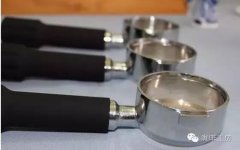Popular Science | Alabica VS Robasta

For professional baristas, please follow the coffee workshop (Wechat official account cafe_style)
Robusta coffee beans (Coffea canephora robusta variety) and Arabica coffee beans (Coffea arabica) are commonly used by ordinary coffee bean manufacturers, and the taste of the two coffee beans will be different with different proportions.
What are the characteristics of these two kinds of coffee beans?
Robusta grows in an area with an altitude of 0800 meters, a temperature of 1836 ℃ and an annual precipitation of 2200-3000 mm. From flowering to fruit ripening for about 7-9 months, its bean line is round, with weak wet aroma (aroma) and woody (woody). The coffee produced has a strong bitter taste and low sour taste. Its caffeine content is 1.8 ~ 3.5%. Robusta coffee beans are generally used for instant solution because they extract twice as much coffee liquid as Arabica.
Arabica grows in an area with an altitude of 600-2200 m, a temperature of 15 °- 24 °C and an annual rainfall of 1200-2200 mm. From flowering to fruit ripening about 7-9 months, its bean shape is long, with a strong and round wet aroma, coffee made from Arabica coffee has a strong complex flavor. Such as: fruit, chocolate, caramel and so on, the bitter taste and sour taste of the coffee are relatively balanced. Its caffeine content is less than 1.5%.
How to distinguish between these two kinds of coffee beans?
Arabica coffee beans: oval shape, zigzag grooves, a bit like half a peanut
Robusta coffee beans: the appearance is relatively round, the middle side of the crack is a little inflated, the groove is very straight
Arabica: the bean shape is small, the front is long oval, the middle crack is narrow and tortuous, and the arc on the back of the bean is flat.
Robusta: the bean shape is larger, the front is gradually round, the back is round and convex, and the crack is straight.
From a flavor point of view:
Arabica: Arabica coffee has a varied and broad potential flavor. Arabica coffee produced in different regions, different elevations and different climates has its own characteristics and can show completely different individual flavor. When unbaked, it smells like grass. After proper baking, it shows "fruity" (medium-shallow baking) and "caramel flavor" (deep baking). It is suitable for single producing area and a variety of mixed beans, and can be made using various extraction techniques (French press kettle, drip extraction drip filtration, espresso machines concentrator).
Medium to high aroma, bright acidity, smooth taste, medium to low mellow thickness, pleasant return
Robusta: mainly used for concentration and blending to increase alcohol thickness, produce thicker grease, and add a specific amount to the cup. Usually use 5-15%, sometimes more than 25% of the total amount of roasted coffee blended.
Medium to low aromatic, low acidity, strong bitter taste, mellow thickness, wood taste, Huigan has pyrolysis and spicy taste
If you want to ask the country or region that loves Robusta beans most, the first place is Italy, the hometown of espresso! To narrow it down further, to be precise, the largest use of robusta beans is in southern Italy, such as Palermo and Sicilia. In fact, in southern Italy, most of the coffee people drink contains a considerable proportion of robusta beans. It is common to have a content of 30% to 60.
Open the list of beans supplied by local wholesalers of raw coffee beans in Italy, and you will see a list of more than a dozen, or even more than 20, raw beans from coffee producing areas around the world for local coffee roasters to choose from. This phenomenon does not exist in other parts of the world, such as the United States and Canada, Northern Europe, Japan and even Taiwan.
You may wonder why Italians mix a lot of robusta in Arabica beans. Generally speaking, Italians mix with Robusta in order to increase the Crema content of Espresso.
This is only half true, and there is another little-known reason.
Once upon a time, southern Italy was a relatively poor region, where people could only afford cheap coffee, so at first it was mixed with Robusta beans simply to reduce costs. However, after years of massive roasting and blending of Robusta, coupled with Italy's natural sensitivity to cooking, they found that Robusta beans have many qualities that Arabica beans do not have. as long as you are familiar with and fully master these qualities, a good coffee roaster will be able to produce Italian coffee beans with photographic magic.
Important Notice :
前街咖啡 FrontStreet Coffee has moved to new addredd:
FrontStreet Coffee Address: 315,Donghua East Road,GuangZhou
Tel:020 38364473
- Prev

It's risky for a coffee shop to join! What skills need to be mastered when coffee joins the store?
Professional barista communication Please pay attention to coffee workshop (Wechat official account cafe_style) Coffee, as a fashionable drink, is now very popular in life, at the same time, some coffee shops in the market, business is also very hot, in the coffee shop operation, what aspects should be paid attention to, in order to better manage their own coffee shop? In recent years, with the coffee industry
- Next

Uncover the secret! Why is Cold Brew suddenly popular all over the world in the past two years?
The exchange of professional baristas please follow the coffee workshop (Wechat official account cafe_style) in April this year, domestic Starbucks began to launch air-cooled cold extract coffee (Nitro Cold Brew). In fact, Starbucks in the United States started selling cold extract coffee in stores in the United States as early as two years ago. Many people see the term Cold Brew, only know that it is more expensive than iced coffee, but why all
Related
- Beginners will see the "Coffee pull flower" guide!
- What is the difference between ice blog purified milk and ordinary milk coffee?
- Why is the Philippines the largest producer of crops in Liberia?
- For coffee extraction, should the fine powder be retained?
- How does extracted espresso fill pressed powder? How much strength does it take to press the powder?
- How to make jasmine cold extract coffee? Is the jasmine + latte good?
- Will this little toy really make the coffee taste better? How does Lily Drip affect coffee extraction?
- Will the action of slapping the filter cup also affect coffee extraction?
- What's the difference between powder-to-water ratio and powder-to-liquid ratio?
- What is the Ethiopian local species? What does it have to do with Heirloom native species?

